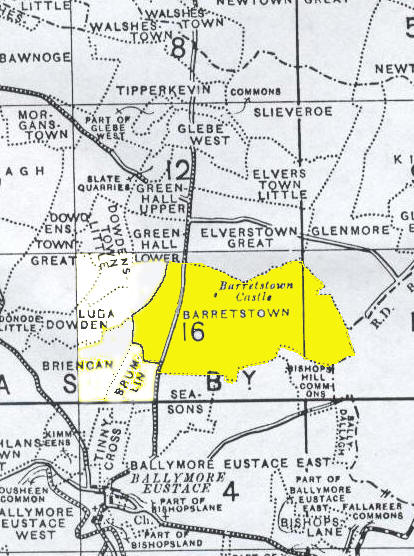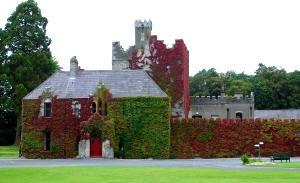 
Map showing
location of Barretstown
|
The adjoining townlands of
Barretstown, Dowdenstown (Great and Little) and Elverstown, in
Tipperkevin Parish, are located about two miles north of
Ballymore Eustace, and until the Dissolution in 1547 formed part
of the Ballymore estates of the Archbishop of Dublin. (There is
liable to be confusion between these two townlands (near
Ballymore Eustace) and those of Dowdingstown and Barrettstown
(south and west of Naas), which were also Eustace lands; see
Castlekeely).
Barretstown stands on the site of a late 12th century
Anglo-Norman Castle and is rumoured to have been built around
the original keep of that ancient edifice. The core of the
castle is a old Eustace Tower house which guarded the pale.
The present early Victorian
castle was built around the old Eustace tower house by the
Borrowes family in the early 19th century.
|
In
Archbishop Allen’s Register it is recorded for the period 1256-66 that
“Eustace son of Godfrey” paid wax- rent, with a note by the Archbishop “perhaps
for Barretstown.” (If Eustace, son of Godfrey was a member of the Eustace
family, this is certainly one of the earliest references
to
the name.)
The
Castle was held by the Eustace family on a series of ‘permanent leases’ for
about two centuries. In 1532, Oliver Eustace held Barretstown in a lease
directly from the Archbishop while the head-rents of adjacent Dowdenstown
and Tipperkevin were paid to the Eustaces of Confey by James, John and Henry
Eustace.
Barretstown Castle is mentioned in a 1547 inquisition held after the suppression
of religious houses, when Barretstown Castle was listed as the property of the
Archbishop of Dublin, from whom it was promptly confiscated by the English
crown. The fate of these lands at the time
of the Dissolution is not known but by the mid-sixteenth century we find
constant references to Eustaces settled in this area.
Walter of Elverstown and Alexander of Dowdenstown lost their estates
in 1641, but Alexander who died in 1643 was declared in 1663 to have been an
innocent Papist and the lands restored to his son Walter Eustace.
(Walter Eustace’s lands included 403 acres in Tipperkevin partly from
Baltinglass forfeitures. They included Morganstown, Elverstown (180 acres),
Burgagemocle (10 acres) and 42 acres near Ballymore Eustace called Talbot’s and
Bennett’s lands. The estate contained four castles. Forenaughts
Great had been mortgaged to Alexander in 1640 to save it from confiscation.)
Walter Eustace appears to have been succeeded by a nephew
Colonel Richard Eustace of Dowdenstown and Barretstown,
son of Maurice who died in 1660. Colonel Richard Eustace, having
been commissioned an ensign in 1673 and captain in 1681, he was
lieutenant-colonel and second-in-command of Lord Gormanston’s
(the 9th) Regiment in King James’s army, and was wounded at both
Derry and Aughrim. His lands, forfeited in 1690, were restored
under the Treaty of Limerick. Richard Eustace first married in
1670 Dorothy Hill, great-aunt of Viscount Hillsborough (father
of 1st Marquess of Downshire), and their daughter, Anne, married
James Eustace of Yeomanstown. He married secondly Margaret,
daughter of Thomas Aylmer of Lyons, by whom he had a son
Maurice Eustace on whose death the estate passed from the
family. (Margaret Eustace, nee Aylmer claimed in 1719 against
the estate of Sir Maurice Eustace of Harristown for a legacy
bequeathed to her son Maurice, and also for a debt owed jointly
to him and Richard of Naas (deceased vide p. 336).
Honour Eustace together with
Richard Eustace of Dowdenstown, are listed on the Convert Rolls
when they converted from Catholicism to Protestantism. Both
were enrolled in February
1765.
Early in the 18th century the
Borrowes family, Baronets of Giltown,
acquired the Barretstown estate, and retained possession for some 200 years.
The Borrowes family housed the Kilcullen effigy (q.v.), now
housed in St John's Church at Ballymore Eustace, until they left
Ireland and vacated Barretstown in 1919.
|
Unlike
the Eustaces of the 16th and 17th centuries, the five Burrowes Baronets who
spanned the 19th century played no part in public life. This quiet aristocratic
reign ended with the flamboyant Sir Kildare, 10th Baronet (1852-1924), whose
father Rev. Sir Erasmus Borrowes, 8th Baronet, had significantly modified the
residence in a medieval, romantic, asymmetrical style.
In
1918/19, Barretstown was purchased from the Borrowes by Sir George Sheppard
Murray, a Scotsman who converted the estate into a fine stud farm, and planted
many of the exotic trees that dominate the landscape.
In
1962 Elizabeth Arden, perfume manufacturer, who acquired the Castle from the
Murray family. Over five years, Ms Arden applied her famous talents for beauty
and style to an extensive reconstruction, redecoration and refurnishing of the
Castle. Her influence dominates the look of the house to this day. The door of
Barretstown Castle is reputed to have been painted red after her famous brand of
perfume 'Red Door', and remains so to this day.
After
Ms Arden’s death in 1967, the international biscuit tycoon Garfield Weston took
up residence. Under his ownership the grounds were significantly improved,
particularly through the addition of a magnificent lake in front of the Castle.
The Weston family, which owns Dublin’s famous
department store Brown Thomas, presented the estate to the Irish Government in
1977, during which time it was used for national and international conferences
and seminars, as well as being used as a part of the Irish National Stud.
Barretstown Castle is now a "Gang Camp" for children afflicted with serious
illnesses such as cancer, sickle cell anemia, hemophilia, HIV/AIDS, and many
other life-threatening disorders. Children of all ages attend. The Gang Camp is
sponsored by the film actor Paul Newman. This camp was the first outside of the
U.S., and is located in a castle in County Kildare, Ireland. More than 1,000
children ages 7 to 16 from 20 different countries attend camp there each year.
The multi-lingual, multinational staff members provide a safe, supportive
environment.
If you know any more about
Barretstown's past or have photos please
email us
or call 00 353 45 864115.
These pages © Ronald Eustice, 2008